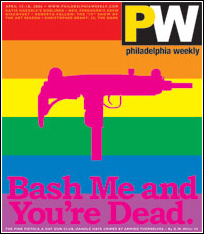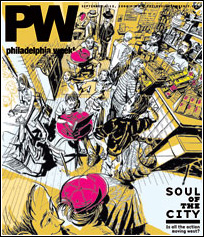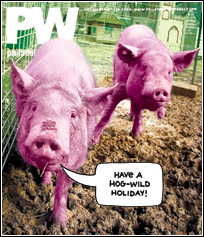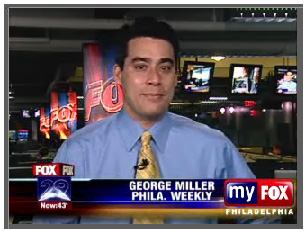Tanks for the memories
PBC makes a fresh start after Yards' departure.
From the February 6, 2008 Philadelphia Weekly
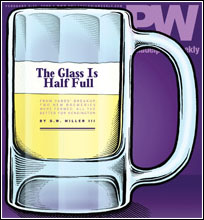
By 10 p.m. they're dancing.
In the cluttered, half-painted temporary tasting room of Kensington's Philadelphia Brewing Company (PBC), darts fly, the B-52s wail, women hop to the beat, and laughter emanates as easily and readily as beer flows from the tap.
Among the two dozen people cavorting in the clubhouse-like space are artists and kindergarten teachers, economists and car dealers, community activists and neighborhood developers.
"They let me come if I bring the shrimp," jokes Dave Nelson, a loft builder who brought homemade bacon-wrapped shrimp.
Of course in the middle of all the activity is the brewery's co-owner Nancy Barton, bopping along with a stainless-steel shaker in one hand and darts in the other.
She takes a swig, sets the shaker down on the long wooden lunch table and throws a dart at the board. As soon as it strikes, she spins and punches her fists in the air triumphantly. Then she grabs her drink, twists her hips and bobs her head to the music again.
Bill Barton, Nancy's husband, sits on a nearby barstool, watching the scene contentedly despite the pounding music and the chaos all around him. Mussed hair and slumped shoulders reveal his exhaustion.
Since Jan. 1 the Bartons and their dedicated crew of employees and friends have hustled 10, 11 and 12 hours a day, seven days a week, to get the new brewery open for business. They've painted the walls, installed new piping, cleaned all the tanks, added windows and repointed the bricks on this building that housed the Yards Brewing Company until Dec. 31.
And now they're finally making beer.
But tonight's revelry isn't a special celebration.
It's just the regular Friday happy hour/weekly party at a place where employees are treated like friends, neighbors are considered family, and everyone chips in to make a better beer and a stronger community.
***
The Philadelphia Brewing Company fired up its kettle this week, and again the sweet, biscuit-y smell of malt floats around the 123-year-old building on Martha Street at East Hagert. Kegs should start arriving at local bars and restaurants by the end of the month.
The distinctive and enticing odor once permeated much of this old industrial neighborhood that had dozens of breweries a century ago. Back then, this building was the home of the Weisbrod & Hess Oriental Brewing Company, makers of 70,000 barrels of beer a year.
Then Prohibition shut the breweries down, the other factories ceased operations, residents fled the area and the crack epidemic struck Kensington with full force.
By the time the Bartons arrived here in 2001 as partners in the Yards Brewing Company, crime was rampant, trash was everywhere and the police were using the building for surveillance.
But Yards was desperate for a location to expand its growing brand. And the building's history seemed perfect.
When they took over the property, it was full of supermarket supplies like deli cases, racks, scales and freezers. The basement was full of shopping carts.
"You couldn't even see the floor," Nancy says.
Martha Street had long been a wasteland, an illegal dumping ground surrounded by graffiti-covered walls. So while the crew at the brewery spent months prepping the building for production, Bill and Nancy organized cleanup days with the New Kensington Community Development Corporation. They invited neighbors to help, enticing them with free beer and barbecued hot dogs.
The Bartons quickly became active members of the evolving community. They joined civic association boards, worked with other local businesses, sponsored community events, and donated beer and time. Slowly, in part because of their efforts, the area is becoming lively again.
"It just needed to happen," Bill says. "Something needed to change."
They began to take pride in where they were despite the neighborhood's longstanding reputation for drugs and prostitution.
"You're not in Fishtown, but tell people you're in Fishtown," people advised Bill.
Instead he had Yards T-shirts printed that boasted, "Welcome to Kensington."
Last August, when the ownership group of Yards dissolved their relationship and settled their nasty, long-overdue business divorce, Yards co-founder Tom Kehoe walked away with the Yards brand, and the Bartons got the building.
That's the way they wanted it.
Because for the Bartons, it's about more than just the beer.
"The part of Yards that helped the community was entirely Bill and Nancy," says Pat McHugh, a neighbor and happy hour regular. "It was Bill and Nancy who brought this community together."
***
"All the businesses have done a lot to make this neighborhood better," says Frank Wilson, a 38-year-old lifelong Kensington resident and happy hour fixture. "But Bill and Nancy have done more for this neighborhood than any other business could."
"You just love us 'cause we feed you beer," Nancy jokes to Wilson, who's vice president of the East Kensington Neighbors Association.
He's a bit tipsy. He has a long, dark beard, and he sports a Carhartt jacket and pants - an ensemble he tops off with a Fidel Castro-style hat.
He stares into space for a moment before citing some of the Bartons' accomplishments in the neighborhood: The brewery hosts the monthly East Kensington Neighbors Association meetings, they sponsor the Trenton Avenue Arts Festival, and they invite volunteers to the brewery after frequent neighborhood cleanup days.
"We feed them beer," Nancy reiterates, downplaying their impact.
They've also donated beer to the Fishtown Neighbors Association, the Orianna Hill dog park, the Music Fest at Liberty Lands Park and numerous other charitable causes. They brewed pink beer for the Susan G. Komen breast cancer awareness events, and they donated $10 from every keg to the foundation.
"That became a big part of the day," says Nancy, who dyes her blond hair pink during the Komen events. "There was a lot of dealing with arts organizations and other groups."
But the community involvement extends beyond giving away free beer.
The brewery has become a focal point for the community. It hosts Buy Fresh Buy Local events and the annual Slow Foods pig roast. Tom Knox held a spaghetti dinner for neighbors in the brewery's tasting room during his mayoral primary campaign. Representatives from the SugarHouse Casino project made their pitch to the New Kensington Community Development Corporation (NKCDC) here as well.
"They do find the time on a regular basis to get involved in a lot of community things," says NKCDC president Richard Levins. "They do that, and they don't have to do that."
Their relationships with community members - the Kenzos - are so tight that the Bartons employed them as taste-testers for the Philadelphia Brewing Company's inaugural beers. They had the happy hour regulars sample four versions of their Rowhouse Red, a French farmhouse ale, to determine which they'd produce.
"It was a really cool thing to be on the ground floor of that," says McHugh.
***
The story of the Bartons and the Philadelphia Brewing Company is directly intertwined with the history of Yards beer. You just aren't allowed to say their former partner's name while you're in the Kensington brewery.
The breakup was that ugly.
Haddonfield native Tom Kehoe began brewing beer in 1988 while attending Western Maryland (now McDaniel) College. He turned his hobby into a career after graduating when he went to work for a small Maryland brewery. Then he and a friend, Jon Bovit, decided to create their own production brewery in Philadelphia.
In 1994 Yards was officially born in Manayunk using a three-barrel system that produced six kegs at a time. They were the first production brewery to open in the city since the 1987 demise of Schmidt's. Yards made about 18 barrels a week, 900 a year, and was profitable right away, Kehoe says.
The craft beer movement was in full swing in the mid-'90s, and Yards developed a following. They quickly outgrew their original 900-square-foot home and moved to Roxborough, where they added a bottling line and a larger brewing system. But as the brewery grew, the finances became more complicated, and the company began to struggle.
Kehoe and the Bartons knew each other through friends, and they'd hang out and drink beer together occasionally. When Nancy, who'd recently been laid off from her job as a mortgage closer, learned of the brewery's financial problems, she volunteered to be a salesperson.
"It just sounded good," she says. "I wasn't doing anything except collecting unemployment."
Bill had been processing transactions at a New Jersey auto brokerage firm and running a staff of 400 people. Then he was fired. He fought the dismissal and won a meager wrongful termination suit. The Bartons took that money and every other cent they could scrounge up, and bought their way into Yards in 1999.
Kehoe made the beer. The Bartons ran the business.
Soon Yards was producing 10,000 barrels a year, and distributing 13 varieties in seven states. They gained recognition across the country - in 2005 The New York Times named their pale ale one of the five best in the nation - and reached an almost iconic status in Philadelphia.
But differences in business philosophy and company goals quickly began to tear the partnership apart.
"About a week into working here, I realized these people don't talk," says Chris Morris, a former Yards salesman who started at the brewery five years ago and now works for PBC.
The Bartons wanted to dominate the Philadelphia market. Kehoe wanted to grow the company.
"Their focus was the building," Kehoe argues. "The building became more important than anything else. It was kind of hard for us to agree on anything at one point."
By early 2006 the Bartons and Kehoe realized their arrangement needed to be terminated. It took nearly 18 long, bitter months to negotiate the settlement.
After the August breakup, Yards leased the space and equipment in the Kensington brewery until Kehoe found his new home on Delaware Avenue. The Bartons made weekly supervised walk-throughs to ensure nothing was being sabotaged.
Today the two sides refuse to speak, and the Bartons have boycotted drinking Yards beer.
***
Kensington, of course, has its own tragic tale.
In the mid-1800s Philadelphia was the "Workshop of the World," and Kensington was its manufacturing heart. Textile mills, foundries, machine-works, glass factories, potteries and furniture makers dominated the smog-filled landscape. The mills of Kensington produced more carpets than all of Great Britain and Ireland combined by the end of the 19th century.
Huge waves of German immigrants arrived in the mid-1800s, bringing with them their passion for beer. The Bavarian John Wagner brewed the first lager in America in 1840 near the intersection of American and Poplar streets in Northern Liberties.
Soon brewers were popping up all around Northern Liberties and Kensington, and their brews were exported to Europe and Asia.
"People would put the name 'Philadelphia' on their beer because it had a connotation of excellence around the world," says beer historian Rich Wagner, who'll give a lecture on Philadelphia brewing history at PBC on March 22.
By the dawn of Prohibition in 1920, there were more than 40 major production breweries in the city and dozens of smaller-scale operations.
When the 21st Amendment repealed Prohibition in 1933, only 19 of the larger facilities reopened. Weisbrod & Hess was among the survivors, but they went out of business in 1939.
After World War II the factories began shutting down one by one, and Kensington lingered like a hospice patient refusing to die. With each factory's demise came increased poverty. As people abandoned the neighborhood, the drug trade moved in.
Fires at former manufacturing hubs made for spectacular video on the evening news. Such was the case with the Quaker Lace building, which was torched in 1994 by drug dealers who didn't appreciate police using the vacant building for surveillance.
Wagner visited the dilapidated two-story redbrick Weisbrod & Hess location in 1983. Gray concrete blocks had replaced the old windows, trash was strewn all over the place, and vines had nearly taken over.
"I never thought I'd see a brewery there," he remembers now. "And I wouldn't have been surprised if it was torn down."
He didn't think much about the place until 18 years later when Nancy Barton called him. She and Bill had been scouting locations for Yards when they stumbled across the complex.
"Hey, Rich," Nancy recalls saying, "There's this sign that says 'bottling plant.' You know anything about it?"
***
"I really loved working here," says Steve Hach, a former Yards delivery truck driver who quit last June to take a job as a stock market research analyst. "It's really a 19th-century workspace - the ownership's mentality, I mean. Everybody works together and there's a sharing of tasks."
It wasn't uncommon, Hach says, to see Nancy and Bill working the bottling line or loading trucks. Every day the staff eats lunch together, with the Bartons usually footing the bill for the 15-member team.
"It's really a pre-capitalistic system," says Hach, who still swings by for Friday night drinks.
When the wife and grandson of a Yards driver were mauled in a pit bull attack, the crew at Yards, led by salesman Chris Morris, organized a benefit party to raise money for the hospital bills. They arranged for area restaurants to donate food, they had seven bands perform, and Yards beer flowed all day.
"We raised about $8,000," says Morris. "It was a good day."
Bill watches over his team like a protective father.
Even after being in the building three years, Bill felt like he needed to walk his employees out to their cars at the end of the workday. There hadn't been any problems, but it was still Kensington.
On a sweltering August afternoon in 2004, after his staff left the parking area across the street from the brewery, Bill spotted the lifeless, battered body of a young girl in the bushes. The 15-year-old Kensington High School student Nicole Reilly had been strangled to death. Her body was dumped in the lot, a block from her Amber Street home.
Friends of the slain girl erected a memorial across the street from the brewery's entrance. It was a constant reminder of why this neighborhood needed the brewery, of why things needed to change.
***
"You have to go through a certain level of shit here," says Mary Seton Corboy, co-founder of Kensington's Greensgrow Farms. "There are people who want Kensington to stay what it was."
Corboy met the Bartons when they arrived at the farm for a spring opening event. They brought beer, and became fast friends.
"There's a lot of simpatico about being in Kensington and what it means to be a business in this community," Corboy says.
She shared her dreams of turning the neighborhood into a Gourmet Ghetto like in Berkeley, Calif. She envisions an area teeming with small food processors and restaurants serving meals made from locally grown products.
"Let's face it," she says. "The factories aren't coming back."
So one day while she was working the bottling line at the brewery - friends of the Bartons frequently assist with production, painting, cleaning and whatever else needs to be done - she noticed caves where beer had been stored a century ago. Nancy suggested that those little nooks would be great places to age artisanal cheeses. Now that the brewery is functional again, Corboy plans to start making cheese there, and the brewery will host beer and cheese tastings.
In return, Greensgrow will grow herbs and cultivate honey that will be blended into special Philadelphia Brewing Company beers. Nancy actually dons netting to extract honey from hives at the farm.
"At every layer you dig, you find the same people getting involved," Corboy says. "And Bill and Nancy are always at the root."
***
During the awkward five months while Yards and the Philadelphia Brewing Company coexisted in the same facility, many of the staffers worked for both operations. Some made Yards by day and tested recipes for PBC by night. Billy Westervelt bottled 95 beers a minute for Yards and then designed the labels and packaging for PBC's four new beers - Rowhouse Red, Newbold IPA, Walt Wit and Kenzinger - on his own time.
"I'd get done over there and then sneak over here to work on the labels," Westerville says.
Loyalties were tested all around - Kehoe invented the beer but the Bartons made it successful. Some bars pulled Yards from their taps. Rustica Pizza changed the Yards logo on their takeout boxes to a Philadelphia Brewing Company design. The beer blogs lit up with vociferous defenses and slanderous attacks on both parties.
In the end, all of the former Yards employees remained with the building, Bill says. One person went to Yards but returned within two weeks.
"Everything that built Yards," Bill says, "became Philadelphia Brewing Company."
During the transition, the Yards crew would leave work on Fridays and climb to the second-floor PBC office space where they'd party all night long.
***
Even these weekly happy hours grew out of the community post-cleanup events. Sweaty neighbors, filthy from digging through abandoned tires and piles of trash, would convene at the brewery where Bill would man the barbecue.
"It'd be a bunch of neighbors talking about what was going on, about new projects going up and about overgrown lots that needed to be tended," says Pat McHugh. "It was a small circle of friends. That circle of friends started expanding."
By last summer the happy hours grew out of control, with 50 or 60 people drinking free beer. It swelled from friends discussing ways to improve the neighborhood to friends of friends having a good time, to complete strangers who'd heard about the event complete with hors d'oeuvres and the occasional London broil on the grill.
"We'd get phone calls asking, 'Are you guys having that happy hour?'" Nancy says.
So when the festivities lost their community focus, she started answering, "No."
"Now it's just family hanging out," she says, "drinking 'cause it's the end of the work week."



